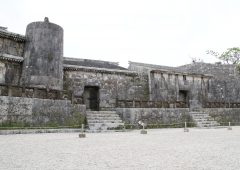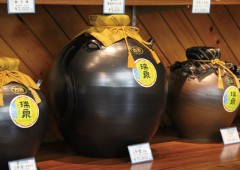2015.11.30
Matrix Banzai 2030: Back to the future of 1940’s Japan
By Edward Heinrich-Sanchez
After living on Okinawa for over 20 years, fairly fluent in the language along with many meetings in Tokyo and around Japan, it is still a challenge to follow what is going on. For those people from abroad who are “in country” due to work, study or tourism… Where do you find out what’s going on?
Anthony Bourdain was in Okinawa and had this segment aired recently titled, “Okinawa isn’t the Japan I know”. Most people who have and are watching this might only remember the Karate Kid or the “Battle of Okinawa”, but what about now? Many film crews have passed by Okinawa such as “Discovery Channel” and “National Geographic” but rarely touch on the protests, which have been going on on Okinawa since the times of Ahagon Shoko, known by many as the “Gandhi of Okinawa”.
Bourdain speaks about the military in Okinawa including an interview (on the full show) with former Gov. Masahide Ota.
In this age of super specific consumerism, there is the issue of too much information. It is always good to have several good sources of un-biased information about the issues. Living in the eternal “present,” our thoughts today are influenced by our own countries narrative. What is in the history books is one thing, yet the movies we see and books we read start shaping our view of the world as we are bombarded by the news.
Most people tend to follow those who are aligned with their points of view. From the “Westerns” and war movies we grew up with, “Little House on the Prairie” and “Bonanza” to “McHale’s Navy” and now Disney’s “K.C. Undercover” based on the exploits of a teenage tomboy who is a math genius. She discovers that her parents are undercover spies. The sets would lead one to believe that her parents work for the CIA.
Imagine that, “Disneyland meets CIA”. When I first saw an episode, it rung a bell, but couldn’t place it. Then I remembered that KC reminded me of William J. Casey who was the 13th director of the CIA. Curious about this connection, I simply Googled to find an interesting article about T.D. Allan’s book, “Finding Florida,” which goes into details on this Mickey Mouse connection.
Disney’s links to the F.B.I. and Hoover is old news. As reported by The New York Times article by Herbert Mitgang (May 6, 1993) “From 1940 until his death in 1966, Walt Disney served as a secret informer for the Los Angeles office of the Federal Bureau of Investigation, according to documents that have come to light under the Freedom of Information Act.” Mitgang further reports, “Details about the film maker’s F.B.I. connection emerge for the first time in “Walt Disney: Hollywood’s Dark Prince,” an unauthorised biography by Marc Eliot to be published in July by Birch Lane Press. Of course that is not last July but over a decade ago. At the last Naha Matsuri (Festival) and parade on Kokusai Street, Mickey and friends joined on their own float. The Okinawa Times October 11th front page picture of them caught my eye as it was taken just in front of a souvenir shop with a big sign that read, “ARMY, NAVY, AIR FORCE, MARINE,” a coincidental reminder that MIckey was recruited a long time ago.
Excuse me for going off track, yet the contents of these paragraphs in parallel will combine for an interesting potion for what a possible future holds for us, as we become exponentially connected seeing the unnamed actors “act” on our behalf.
According to the United Nations, the Millennium Development Goals came to a close this year while world leaders have gathered from September in New York to agree on the Sustainable Development Goals (SDGs).
“The Sustainable Development Goals, also called Global Goals and Agenda 2030 are an inter-governmentally agreed set of targets relating to international development. They will follow on from the Millennium Development Goals once those expire at the end of 2015 ” (Wikipedia).
In time for this meeting, Steven C. Rockefeller wrote an essay (preface by Leonardo Boff) titled “Democratic Equality, Economic Inequality, and the Earth Charter” published by Earth Charter International (San Jose, Costa Rica). “The essay explored the origin and meaning of the principal of equality, considers the economic implications of the ideal, and provides a brief historical overview of liberal democracy and economic inequality since the American (USA) and French revolutions. The essay concludes with reflections on equality and sustainability as two transformative ideals that have become interrelated and are the principal keys to a promising future”.
A few weeks ago when politicians turned pro-wrestlers in the parliament as Prime Minister Abe’s administration led by the Liberal Democratic Party (LDP) forced through the controversial “Security Legislation”, I was surprised the National Public Radio’s (NPR) “All Things Considered” was reporting about Japan but not about the tens of thousands of people protesting, nor about the scuffles in the Diet. It was reporting about how salmon made it to the Sushi menu.
For those who are not familiar with the LDP, “it was formed in 1955, heavily funded by the CIA from the 1950’s through the 1970’s” (Wikipedia). This was first exposed by The New York Times (Tim Weiner Oct. 9, 1994).
LDP is in power thanks to a coalition with the Komeito party which is the political arm of the Soka Gakkai International (SGI) Buddhist Sect. Some consider it “cult like” in its actions. It is a key supporter in Japan of the Earth Charter yet in light of recent developments, the party’s actions are not only contradicting the spirit of the Earth Charter, but ignoring its own members who have increasingly joined the protests opposing changes in Article 9.
In the October issue of the SGI Quarterly “The World in 2030” page 1 it asks, “What kind of World will we inhabit by 2030? What is certain is that the future will be shaped by our actions and attitudes now. Conversely, however, our responses in the present are greatly influenced by what we believe the future will be like”
It continues with quotes from Noam Chomsky who wrote: “Optimism is a strategy for making a better future. Because unless you believe that the future can be better, you are unlikely to step up and take responsibility for making it so.” The first page ends with, “as SGI President Daisaku Ikeda writes, ‘the solidarity of ordinary people that, more than any other force, will propel humankind in our efforts to meet the challenges that face us.”
Last month, thousands of SGI members signed a petition against Komeito support for the recent security legislation. As reported in the news, SGI members were refused an audience with Komeito leadership asking them to leave the thousands of signatures with security at the front desk. Contradictions abound as those challenged decide to sweep controversy under the rug.
I was saddened and surprised that NPR has missed this story of Japan’s present and historical turmoil. One publication, which in my opinion, does a pretty good job of reporting objectively is the good ol’ Stars & Stripes. The Japan Times is also a great source of English information. Of course, I recommend readers to try and listen to both sides. I regularly listen to Rush Limbaugh and other sources in order to get a good sense of what is out there. Of course, it is always interesting to look at how then the official word is put out by ALL of those involved. This takes me to two recent posts I read and would like to share with JU readers as we try and find a way out of the present clashes on our island home.
What is all the hubbub concerning the Japanese constitution? Please consider catching up on this issue with Douglas Lummis’ analysis of what the constitution is and what it is not along with the LDP’s proposed reforms.
It Would Make No Sense for Article 9 to Mean What it Says, Therefore It Doesn’t. The Transformation of Japan’s Constitution 日本国憲法の変容 9条の文面は意味不明。しかるに文字通り受け止めるべからず C. Douglas Lummis,The Asia-Pacific Journal, Vol. 11, Issue 39, No. 2, September 30, 2013. http://japanfocus.org/-C__Douglas-Lummis/4001/article.html
Its back to the future of 1940 standards only now with Internet, super computing and drones.
After reading this, keeping it in mind, take a look at the latest predictions by Ray Kurzweil, director of engineering at Google. As reported in Peter Diamandis’ newsletter (Oct. 12, 2015) titled “Ray’s wildest prediction,” “In the 2030’s,” said Ray, “we are going to send nano-robots in the brain (via capillaries) that will provide full immersion virtual reality from within the nervous system and will connect our neocortex to the cloud. Just like how we can wirelessly expand the power of our smartphones 10,000 fold in the cloud today, we’ll be able to expand our neocortex in the cloud.” Peter Diamandis (blog) then continues with, “Let’s digest that for a moment. 2030 is only 15 years away… Directly plugging your brain into the internet?”
Every week he sends out a”Tech Blog”. To sign up go to http://www.diamandis.com He covers The Basics, Brain to Brain Communication, Google on the Brain, Scalable Intelligence, Living in the Virtual World, Extended Immune System, Downloadable Expertise, Expanded and Searchable Memories and finally… A HIGHER ORDER OF EXISTENCE. Peter’s blog is about “the staggering (and fun) implications of that future”.
Yes, I am an optimist. I feel happy that H.H. Pope Francis and along those lines H.H. Emperor Akihito is on the path of reconciliation with the world. Pope Francis is a fan of the Earth Charter. I admire Peter Diamandis’ enthusiasm yet I can see the dark side of these nano-robots in our brains. In an analogue but patient way, generations since 1945 in Japan have had their ability to question authority nicely trimmed “Bonsai style” in a controlled cloud. With liberal arts being attacked, English levels at record low and declining innovation.
The architects of a “beautiful Japan” are finding success in defusing critical thinking as they push for Japanese not to be citizens but subjects of the state with ONE GOD and the Prime Minister as the ONLY prophet.
Who is really in the Mickey Mouse suit? Of mice and men, its ALL about the money and greed. We have a long way before that “higher order of existence”. It’s about the money for those who love money and power more than they love Okinawa.
Recommended reading for those who serve while raising children, “Blow Back” and “The Sorrows of Empire” by Chalmers Johnson.
For comments and suggestions on this article, please contact edo@okinawaocean.org
DISCLAIMER: The views and opinions expressed in this column are solely those of the author and not those of Japan Update, Ryukyu Press or their employees.

 2024.07.07
2024.07.07 2024.06.21
2024.06.21 2024.05.15
2024.05.15 2024.02.07
2024.02.07 2024.01.31
2024.01.31 2023.11.02
2023.11.02 2023.10.26
2023.10.26 2023.09.29
2023.09.29 2023.09.01
2023.09.01






